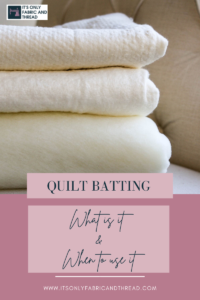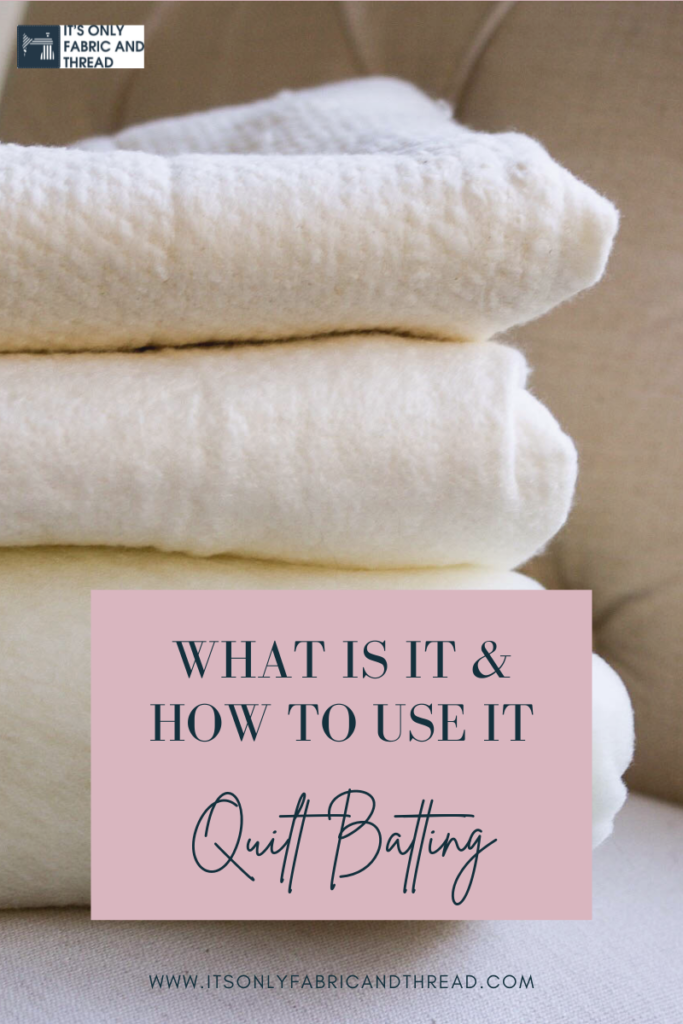Quilt batting or wadding is used in a variety of sewing and quilting crafts. The middle of your “quilt sandwich” is called quilt batting. It serves as an insulator between fabrics and quilts’ stuffing, making them warm and sometimes weighty.
Key Batting Features to Keep In Mind
Like many other things, there are some key features you have to be aware of before you decide on your particular batting. This list will help guide your batting to quickly figure out what specific batting you need and why it is appropriate.
Batting Loft
The batting’s height, thickness, and “loft.”
When compared to thick batting, low-loft batting, or thin, lightweight batting will not only make a quilt easier to weave, but it will also have numerous advantages. It is more convenient to work with. It is much easier to get through thin batting than thick batting since it is crucial to have tiny, even stitches throughout the quilt.
For warmth or design reasons, you may prefer a thicker batting or a higher loft. A greater loft produces more “puff” in the quilt and highlights the quilting a little more. It is most commonly used in colder locations where the increased thickness provides much-needed relief.
How you Plan to Quilt & Quilting Distance
The type of batting you pick will determine how you quilt it and how dense your quilting should be. Some varieties of quilt batting require quilting every 3 to 4 inches, while others can be quilted up to 12 inches apart and still remain stable. Which batting is ideal to use on a particular quilted project depends on how you want to finish your quilt. Some battings are better for hand quilting than others for machine quilting. If you plan to tie the quilt, some battings will work well, while others may not.
Scrim vs. No Scrim
A thin coating of stabilizer, known as scrim, is sometimes added to batting. This thin layer is needle-punched in to the batting to give it more strength. Scrim batting provides for more space between quilting rows, although it is not suggested for hand quilting.
Basting Method of Choice
One last thing to think about is how you’ll baste your quilt. Some batting kinds are “fusible,” which is helpful if you want to iron it to your quilt top to secure it before stitching.
Types of Batting for Quilting
Cotton
Cotton batting is the heaviest but also the most breathable natural fiber. It has the feel of a thick flannel and is better for machine quilting. Cotton has a plethora of advantages. Cotton batting is less likely to move around during quilting. Some cotton battings are bonded, which producers use to keep fibers together, so they don’t shift or beard. Cotton comes in three colors: natural, black, and bleached.
Because cotton batting does not split or shift inside the quilt, it is used in most of today’s heirloom quilts. Cotton batting does not bunch up in the wash as long as your project is tightly quilted, and while stiff at first, cotton allows your quilt to soften and become more malleable with age.
Cotton batting has a particular disadvantage as well. When washed, it tends to shrink. Pre-washing it before using fabric in a sewing project can help prevent this. Some textile artists however, adore this, and for this reason, they refuse to pre-wash their batting.
Polyester
Polyester batting is a man-made fiber that, unlike other fibers, retains its shape and thickness. It is one of the most prevalent forms of batting. It is readily available at many high-end stores, and is ideal for making quilts as well as cribs and bedding. Polyester is thicker but lighter than wool, so it keeps you warm without adding to your weight. It’s non-breathable, so it’s easy to overheat when using it, but it’s mold and mildew resistant. Although polyester quilt batting does not shrink and dries rapidly, it does not drain moisture away as well as natural fibers.
Low Loft fabrics are excellent for hand-quilting because they don’t need to be quilted as closely. Higher Loft quilting fabrics are ideal for people who want their quilting to stand out. For a thicker quilt, use the highest loft polyester batting, which is also the easiest to knot.
It may be vital to remember that polyester batting in a quilt may melt in case of a fire. Polyester batting is prone to bearding as well. Polyester batting is also one of the more affordable options, which is ideal if you’re on a budget.
Wool
Wool batting is environmentally friendly, warm, and soft. It could be the warmest quilt batting on the market. It is a lofty and natural alternative, which keeps its shape and bounces back. You can quilt it either by hand or machine, and it can also be knotted. It absorbs moisture and is ideal for usage in damp and chilly environments. Wool batting is popular among hand quilters because it resists folding and creasing and has an excellent stitch definition for displaying elaborate machine quilting. It’s also lovely to hand quilt all the way through.
Bamboo
The bamboo plant is used to make bamboo batting. As a result, it’s a naturally hypoallergenic and sustainable product. Because bamboo is a fast-growing plant, its products are environmentally friendly. This type of batting is wonderfully soft and supple to the touch, and with great loft and a thin scrim makes machine quilting a breeze. It’s machine washable and shrinks by 2% to 3%. Bamboo is turned into a beautiful fabric utilizing low-waste, pollution-free technologies.
It won’t make you sneeze as batting, it’s easy to quilt through, and it’s a cooler option than polyester. Great for summer quilts and projects that don’t require a lot of warmth, such as wall hangings. On the other hand, bamboo is more expensive than cotton, polyester, or cotton/poly blends.
Fusible
A fusible web is included in fusible batting, allowing you to baste layers together. Layer the quilt backing, batting, and quilt top together when using fusible batting. Using the wool setting on your iron, push from the center out for 3-4 seconds on each spot. Allow the quilt to cool before continuing on the opposite side.
On both sides of the batting, a fusible resin is used. By simply pressing the three layers together, you may “baste” a quilt. This is a temporary fusing method that is best used on smaller tasks.
Have more questions about Batting? Feel free to leave the question below and I’ll get back with you 😊


I’m looking for a filling or batting to use for a lightweight summer quilt. Something to use as a throw around a pool for a cancer patient